The Vision of a Renewable Rikers Island in NYC
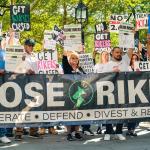
Along, narrow bridge spanning the East River in New York City is the sole link between two realities. To the south, the familiar city skyline stands tall. To the north, walls of barbed wire enclose the site of an ongoing human rights crisis: the Rikers Island jail complex. This bridge, known to justice-impacted New Yorkers as “the bridge of pain,” is a constant reminder of their isolation from loved ones.
Rikers, located on an island between the boroughs of Queens and the Bronx, is one of the largest jail complexes in the United States. It houses nearly 6,000 people, the vast majority of whom are pretrial defendants who have not been convicted of a crime.
Rikers is notorious for its dire conditions and high death rates. “Almost everybody is worse off for spending any amount of time at Rikers,” says Zachary Katznelson, policy director at the Independent Commission on NYC Criminal Justice and Incarceration Reform. “It’s an incubator of violence and misery.”
Since the beginning of 2022, 28 people have died on Rikers. Correctional officers doled out 400 head strikes since the beginning of last year, compared to 52 at Los Angeles County jails during the same period, despite L.A.’s larger jail population and notoriety for use of excessive force.
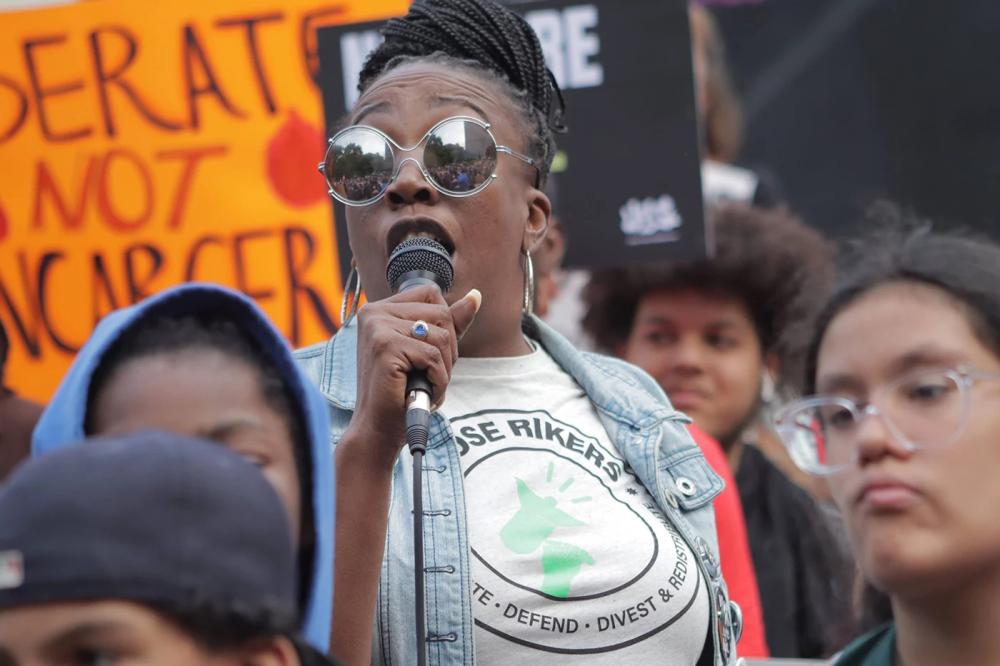
Hope Sanders. Courtesy of Freedom Agenda, photo by Edwin Santana
“It’s a dark and dank and dreary place,” says Hope Sanders, who was sent to Rikers in the mid-’90s at age 16. It was clear to her as soon as she arrived that “ was unsafe for children” like herself. “The officers called us ‘animal-lescents,’” she says. Sanders vividly remembers the stench of rotting garbage, as well as mice, roaches, and the “terrible” air quality.
Beyond the well-documented issues of violence and neglect, there is another hidden danger that looms at Rikers: The jail was built on a landfill, and its decomposing garbage emits methane gas. “We know that methane does very bad things to human beings, in addition to what it does for the climate,” says Rebecca Bratspies, law professor at the City University of New York School of Law and director of the Center for Urban Environmental Reform.
But some advocates envision a different future for this island. In response to the shocking reports of violence and toxic conditions at the facility, justice-impacted individuals devised a plan to shut down the jail and repurpose the island. The Renewable Rikers plan aims to transform the facility into a hub for renewable energy—a source of hope amid the ongoing threats of violence and climate change. The proposed project seeks to benefit the people and communities that Rikers has historically harmed.
A Toxic Foundation
In 1884, the year New York City bought Rikers Island, it occupied less than 88 acres. In the following decades, the city hauled in garbage and ash to expand the landmass, with the landfill labor performed almost entirely by incarcerated people. By 1932, when the jail opened, the island had more than quadrupled in size to 413 acres.
The landfill is a weak foundation for the buildings on Rikers, contributing to crumbling infrastructure. Katznelson describes seeing blankets covering the floors to absorb the rainwater flooding one building during a recent visit. He says the buildings are “so far gone” that they are not fixable and even serve as a source of weapons at Rikers, posing yet another safety risk to those inside. “You can just break [a piece] off almost anywhere, and you can use it as a weapon. It’s just a living, dangerous thing,” Katznelson says.
Isolating toxic waste and polluting industries in minority and lower-income communities is a common practice in this country, and that inequity is exacerbated in prisons. As in the greater U.S. prison population, Black and Latinx individuals are disproportionately incarcerated at Rikers, which pulls 90% of its population from these groups, who represent just 52% of NYC’s general population.
One-third of state and federal prisons in the U.S. are located within 3 miles of a federal Superfund site. Exposure to these hazardous waste sites poses a threat to incarcerated people’s health, but due to the terms of their incarceration, they have no way to escape this threat.
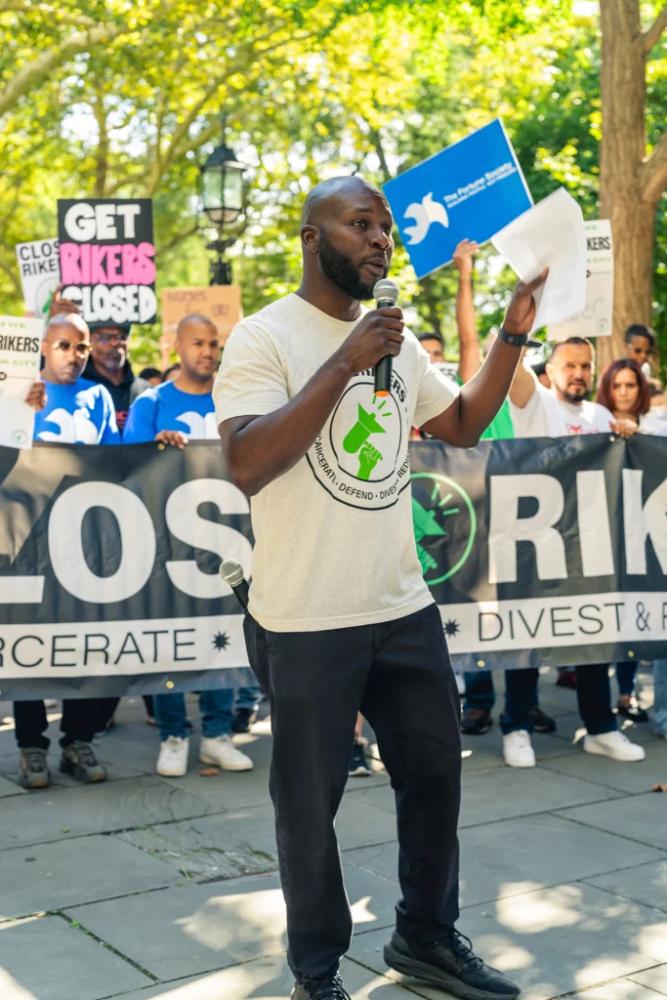
Darren Mack. Courtesy of Freedom Agenda, photo by Shanaz Deen
When Darren Mack was incarcerated at Rikers in the 1990s, he was unaware of the toxic conditions that existed around him. “It wasn’t until I actually went back to Rikers as a volunteer for a restorative justice pilot project for adolescents that, for the first time, I saw a sign that said ‘Don’t drink the water,’” says Mack, co-founder and co-director of a grassroots decarceration organization called Freedom Agenda. Though visitors were advised to avoid drinking it, “people who are detained there are forced to drink the water,” he says. “That was a red flag.”
Rikers was designed to be out of sight out and out of mind—a theme consistent throughout U.S. environmental sacrifice zones. A New Yorker myself, I did not know Rikers Island existed until I had to. When I was 11 years old, my older brother was arrested and sent to Rikers to await trial. Suddenly I saw the tremendous pain, suffering, and injustice Rikers inflicted.
Like half of the people at Rikers, my brother suffers from mental illness. He spent the majority of his 18-month term in solitary confinement, an inhumane and overutilized practice. At the time, I struggled to understand what my brother was going through. Now, having spent the past year researching and reporting on the issues at Rikers, I know the conditions are worse than I could have imagined.
In 2012, a group of cancer-diagnosed correctional officers filed lawsuits against the city and the Department of Corrections (DOC), claiming their diseases were the result of their exposure to the toxic landfill while working at Rikers. The city denied the victims’ claims, and their cases were dismissed.
In addition to methane in the air on Rikers itself, the island is less than a mile from Hunts Point, a predominantly Black and Latinx neighborhood in the Bronx that has been coined “Asthma Alley” due to dangerously high levels of PM2.5 (fine particulate matter less than 2.5 microns in diameter). Rikers is also in LaGuardia Airport’s flight path, exposing those at Rikers to carcinogenic exhaust and significant noise pollution from the more than 1,000 flights that take off and land at the airport every day.
A Cleaner, Fairer Future
After decades of anti-Rikers advocacy and awareness-building, a successful movement finally took hold. “For the first time, in 2016 a grassroots campaign of survivors of Rikers like myself, family members, allies, and organizational partners built a broad-based movement that was so deep that it changed the hearts and minds of New Yorkers,” Mack says.
Sanders, after serving a 20-year sentence, went back to school to become a social worker and joined the Campaign to Close Rikers, alongside Mack. “My experiences [at Rikers] angered me, but also gave me a passion to move forward and do everything that I could to try to prevent [others from suffering the same fate],” Sanders says.
As a result of the #CLOSErikers campaign—and a subsequent report by the council-appointed Lippman Commission that concluded that the facility should be shut down—advocates’ demands have become stated policy: The city has committed to closing Rikers by 2027.
The city’s decarceration plan involves a drastic reduction in the city jail population; a transition to a smaller, borough-based jail system; and an increase in hospital beds to treat the many people behind bars who are in need of treatment rather than incarceration. However, due to the recent rise in the city jail population, critics argue that a jail system half the size of the current one cannot keep New Yorkers safe, inevitably leading to overcrowding in jails and an increase in those they deem “violent criminals” on city streets.
“The reason we’re closing Rikers—the reason we’ve been making this argument for years—is that Rikers undermines safety every day that it’s open,” Katznelson says. He says that violence is so embedded in its ethos and its infrastructure that the jail is beyond reform. “You can’t bring a whole new culture and way of operating the existing structure. You need a clean break from what you have.”
The proposed borough-based jail system, Katznelson says, could streamline NYC’s notoriously slow and bogged-down judicial system, which would reduce the number of people in jail awaiting trial.
The mandate to close Rikers has opened doors for imagining future uses of the island. Four hundred acres is a substantial landmass in New York, the most densely populated city in the U.S., with 26,403 people per square mile.
Proposals have included using the land as an extension of LaGuardia Airport or as the site of affordable housing. But these proposals fail to get to the root of the environmental concerns on the island and would continue to expose its next residents to toxic conditions. Justice-impacted New Yorkers wanted to break the cycle of harm.
Those who have spent time at Rikers “almost unanimously requested that the jail be closed and that the land be used for something positive. That would in many ways be the best memorial and honoring of the suffering that’s happened there,” Katznelson says. From this aspiration, a visionary plan has emerged that seeks to simultaneously address two of the biggest, most difficult-to-solve disasters of our time: mass incarceration and the climate crisis.
The plan for Renewable Rikers envisions replacing the facility with green infrastructure to help the city reach its goal of 100% clean electricity by 2040. This would allow the city to replace its antiquated wastewater treatment facilities with new, more efficient technology on the island. “New York is continually in violation of the Clean Water Act because we don’t have the capacity to adequately clean and treat the water we release,” Bratspies says. Renewable Rikers would change that. “It’s like a win-win-win!”
Solar panels and battery storage on the island would replace oil- and gas-fired peaker plants, which are activated during times of high energy demand. In New York City, peaker plants are located predominantly in communities of color, “spewing pollutants,” says Bratspies. Shutting them down would significantly improve the air quality and health outcomes in these communities, she says.
Sanders, who now lives in the Bronx, sees a peaker plant every day while walking in her neighborhood. If such facilities were shut down, Sanders envisions using the land for “green parks where children could play, without having to worry about traffic or warehouses or peaker plants—somewhere where they can really just enjoy nature.”
While Rikers’ isolation has worsened its conditions as a jail, as a renewable energy site this isolation works to its advantage. “One of the concerns you have with battery storage is potential for fires,” Bratspies says. “An island where nobody’s living is probably a really good place to have a lot of dense battery storage.”
In keeping with its restorative justice philosophy, Renewable Rikers would offer a job training program for people whose lives have been upended by incarceration. Advocates believe the program will also aid larger decarceration goals: “If you help people flourish, your needs for policing and incarceration plummet,” Bratspies says.
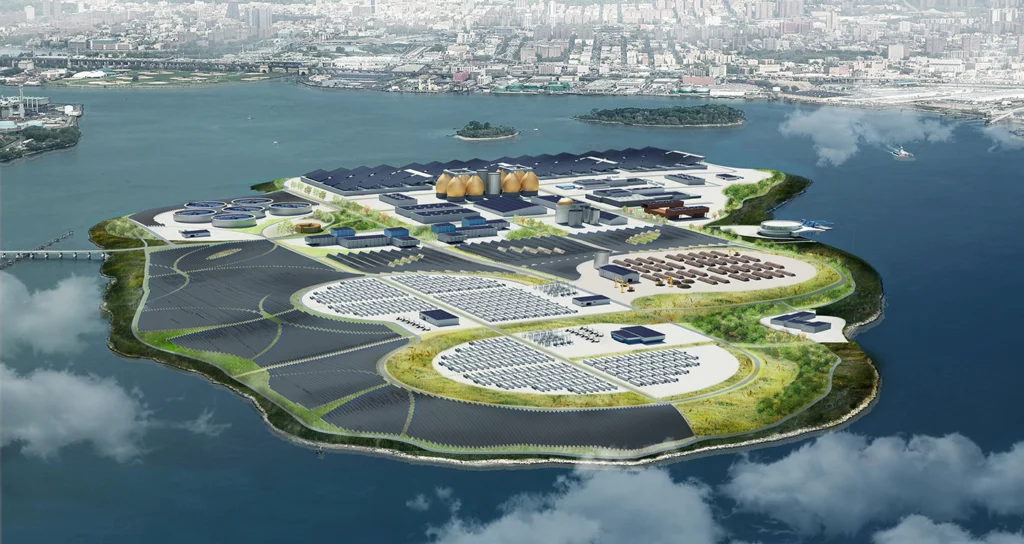
Renewable Rikers. Courtesy of Andrea Johnson for Regional Plan Association
The City Signs On
Renewable Rikers has the potential to set a new standard. Though cities nationwide are seeking to close their jails and reduce jail populations, no others have developed a plan that also incorporates climate solutions. Renewable Rikers can serve as a model for how to simultaneously decarcerate and decarbonize.
When the City Council and then–Mayor de Blasio successfully passed the Renewable Rikers Act in 2021, the vision moved one step closer to becoming a reality—and one step closer to offering justice for survivors like my brother, Mack, and Sanders.
The act mandates a study of the island’s capacity for renewable energy and the transfer of any unused land and buildings from the DOC to the Department of Citywide Administrative Services. But since Mayor Adams took office in 2022, he hasn’t initiated the land transfer or appointed commissioners to the Renewable Rikers advisory committee. “The crisis has exacerbated under his administration,” Mack says. “He’s on the wrong side of history.”
Rather than outside “experts” or academics imposing a solution to the problem, “[Renewable Rikers] was developed alongside, and in many ways by, people who are formerly incarcerated and people who live in environmental justice communities,” Bratspies says. “This is a very different way of thinking about policymaking.”
Sanders, now a member of the Renewable Rikers advisory committee, offers insights and recommendations from her own and others’ experiences on the island. “We are asking those directly impacted, ‘What do they want it to look like?’” she says.
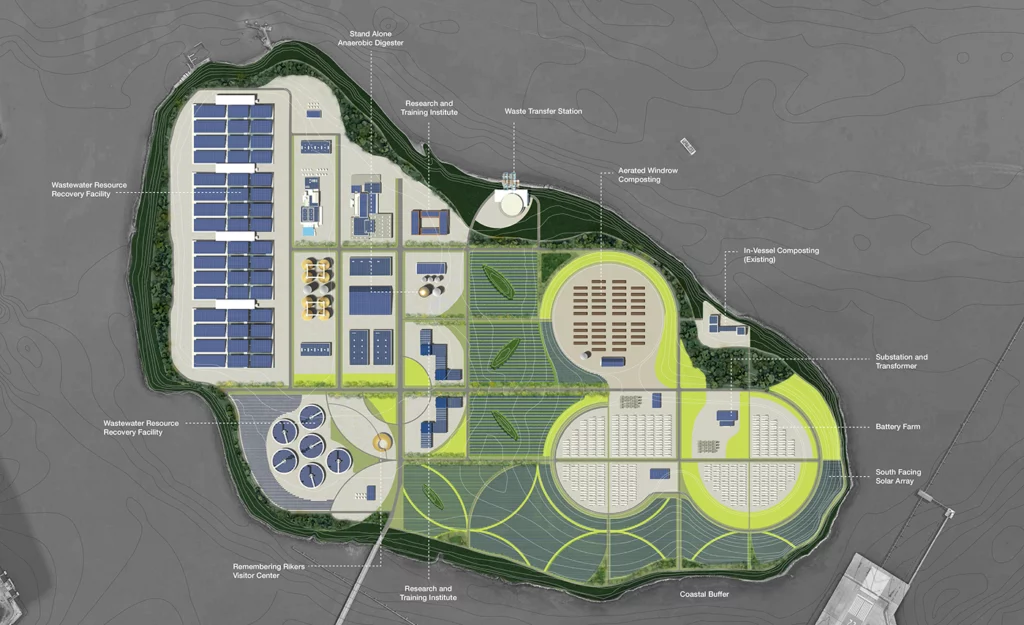
A map illustration of Renewable Rikers. Courtesy of Andrea Johnson for Regional Plan Association
Despite facing resistance, activists and policymakers remain committed to the end of Rikers as we know it. City Council Member Carlina Rivera, who chairs the council’s Committee on Criminal Justice, is resolute on the council using its powers to ensure Mayor Adams adheres to the planned closure. “This administration bears the burden of demonstrating that they’ve marshaled every possible resource to keep the plan,” Rivera says.
At the end of October, the City Council announced the reappointment of the Independent Rikers Commission to ensure that Rikers shuts down by the mandated August 2027 deadline. The Rikers Commission 2.0 plans to take a renewed look at the current conditions at Rikers and aims to find the quickest and safest path to closure.
“It’s the morally right thing to do to close Rikers Island,” Mack says. “And we hope that we can move forward towards a city that removes a stain that has harmed generations of Black and Brown New Yorkers.”
Claire Greenburger is a journalist, writing about climate justice, the environment, and mass incarceration. She has a degree in environmental justice from Middlebury College. She currently works as an editorial intern at Harper's Magazine. Claire is based in New York City.
YES! Media is independent and nonpartisan. Our explanatory journalism analyzes societal problems in terms of their root causes and explores opportunities for systemic, structural change. Our stories uncover environmental, economic, and social justice intersections. Our solutions reporting spotlights the ideas and initiatives of people building a better world. Our commentaries address dominant economic, political, and social structures and consider alternative ways of thinking that can produce a more equitable and Earth-friendly world.
